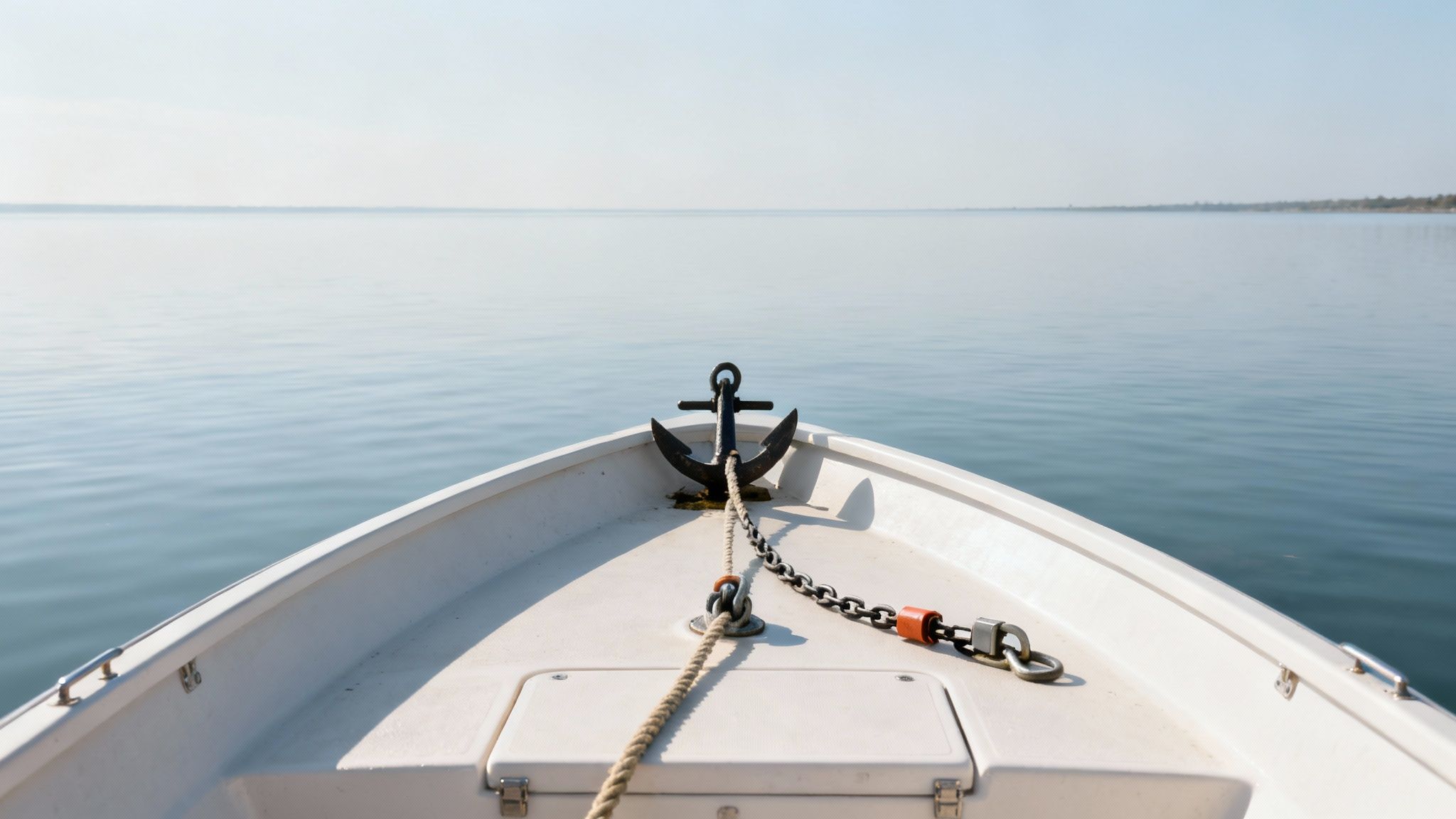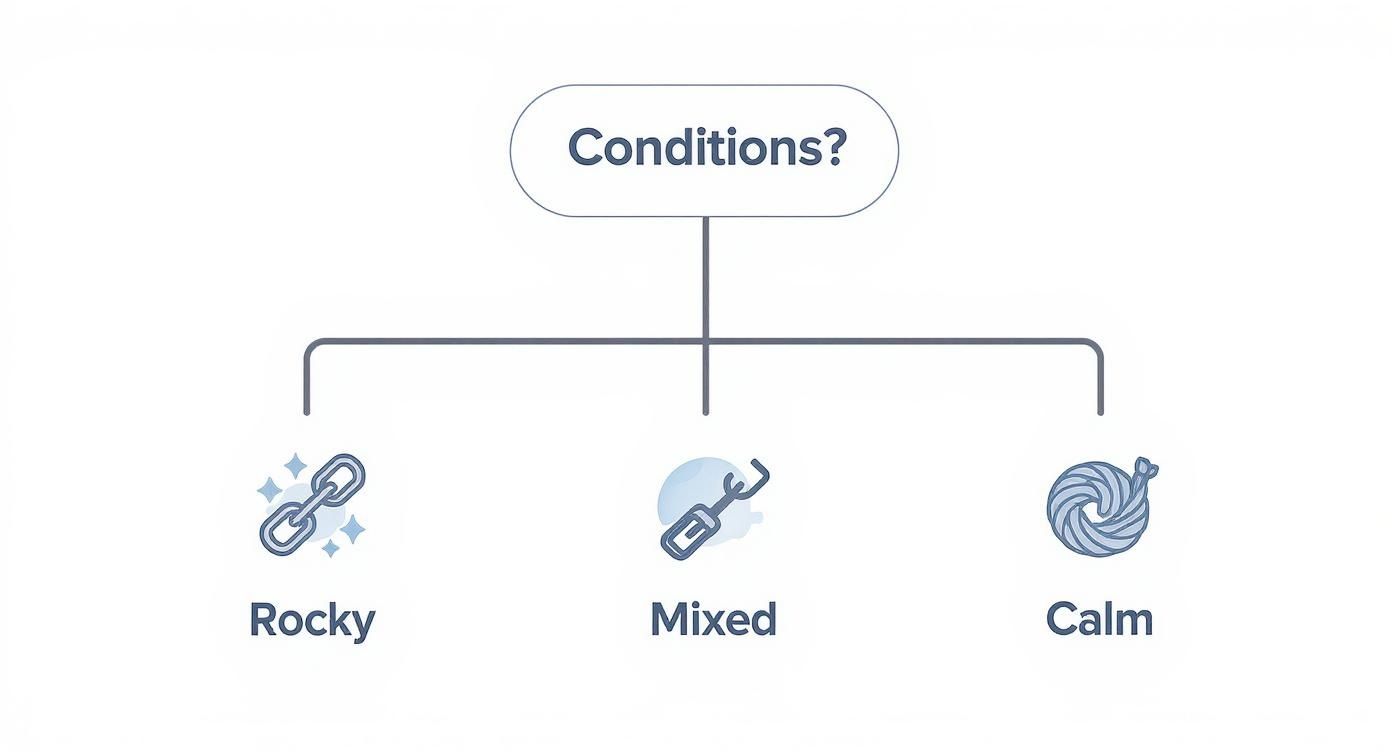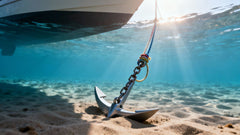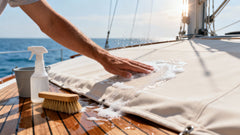Your Complete Boat Anchor System Guide
A boat anchor system is a whole lot more than just a heavy piece of metal you toss overboard. It's a carefully coordinated team of components designed to dig into the seabed and keep your vessel from drifting away with the wind or current.
The real magic isn't just in the anchor itself; its effectiveness comes from the anchor, the rode, and all the connectors working together in perfect unison. Getting a handle on how these parts interact is the first step toward safe, stress-free anchoring.
Your Boat's Braking System On The Water

It helps to think of your anchor system as the parking brake for your boat. Just like the brakes on your car, it’s not one single part doing all the work. Instead, it’s a team of specialized gear that holds you securely in place. The whole process is a clever bit of physics that generates incredible holding power.
The entire setup is designed to transform the downward weight of your gear into horizontal resistance. When you drop anchor, you're not relying on its weight alone to stop the boat. The anchor is shaped to dig into the seabed, while the weight of the rode—the line or chain connecting everything to your boat—helps keep the pull horizontal. That angle is the secret sauce that allows the anchor to bury itself and get a firm grip.
The Three Core Components
Every solid boat anchor system is built around three critical elements. Each piece has a specific job, and if any one of them fails, it can compromise the whole setup. For a deeper dive into the mechanics, check out our guide on how an anchor works to generate that essential holding force.
Here’s the breakdown of the primary components:
- The Anchor: This is the tool that does the digging. Different designs are made for different types of seabeds, whether it's sand, mud, or rock.
- The Rode: This is the line, chain, or a mix of both that connects the anchor to your boat. It provides the length and weight needed to maintain that all-important horizontal pulling angle.
- The Connectors: These are the small but mighty pieces of hardware, like shackles and swivels, that securely join all the components together.
A common mistake is thinking a heavier anchor is automatically a better one. In reality, the design of the anchor and its ability to set properly in a specific seabed are far more important than sheer weight.
Knowing the fundamentals of how an anchor system works is non-negotiable for safe boat handling, a core responsibility outlined in the duties of a Dive Boat Captain. Once you appreciate how these pieces fit together, you’ll be in a much better position to choose, install, and maintain a system you can truly depend on.
A Deep Dive Into Your Anchoring Gear
Let's get past the basics. A truly bombproof boat anchor system is more than just the anchor itself. It’s a team of specific, high-quality components, and every single piece—right down to the smallest shackle—has a critical job to do in keeping you put. Once you understand how these individual parts work together, you can build a setup you can trust, no matter what the weather decides to do.
It all starts with the anchor, of course. That's the part designed to bite into the seabed and hang on for dear life. Its holding power comes from its unique shape, which allows it to bury itself when you pull on it horizontally. This is exactly why the rest of the gear is so important; it’s all designed to create that perfect horizontal pull.
The Rode: The Lifeline to Your Anchor
The rode is simply the line or chain connecting your anchor to the boat. But it's so much more than a rope. The material and weight of your rode are what control the angle of pull on the anchor, and getting that right is everything. You'll generally run into three types of rodes, each with its own pros and cons.
- All-Chain Rode: This is the heavyweight champion, and for good reason. All that weight creates a natural sag, called a catenary, which acts like a giant shock absorber. It’s also incredibly tough and shrugs off chafe from rocks or coral like it's nothing.
- Nylon Rope Rode: Lightweight, easy on the wallet, and simple to handle, nylon is a very popular choice. It has a natural stretch that provides fantastic shock absorption, which eases the strain on your boat and its hardware. You’ll almost always see it paired with a short piece of chain at the anchor end.
- Combination Rode: This setup aims for the best of both worlds. It uses a shorter piece of chain (15-30 feet is typical) connected to a much longer nylon line. The chain handles the abrasion down on the seabed, while the rope provides the stretch and keeps the overall system lighter.
The demand for this kind of durable gear is absolutely massive. In 2023, the global market for ship anchor chains was valued at a staggering USD 112.38 billion. That number just shows how critical this equipment is to maritime safety. It's expected to balloon to USD 260.9 billion by 2032, which tells you innovation isn't slowing down. You can see more details on this growing market over at Introspective Market Research.
Material Matters: Galvanized vs. Stainless Steel
When you're picking out chain, shackles, and swivels, your main choice will be between galvanized and stainless steel. If you decide an all-chain rode is right for you, our durable anchor chains deliver serious holding power and a long service life.
- Galvanized Steel: This is the trusty workhorse. It offers fantastic strength and fights off corrosion at a price that’s hard to beat. The protective zinc coating is what keeps the rust away, making it a perfect fit for most boaters.
- Stainless Steel: Valued for its top-tier corrosion resistance and that beautiful polished look, stainless is the premium option. It definitely costs more upfront, but it demands less maintenance and keeps its shine for years.
The choice really boils down to budget versus long-term upkeep. Galvanized gives you excellent bang for your buck, while stainless is an investment in both performance and appearance.
Essential Hardware: The Unsung Heroes
Finally, a few small but mighty pieces of hardware tie everything together. Think of these connectors as the critical links in the chain—if one fails, the whole system fails.
- Shackles: These U-shaped metal fittings are the go-to for connecting the anchor to the rode and the rode to the boat. Never skimp here; always use a high-quality shackle that's properly rated for your boat's size.
- Swivels: Placed between your anchor and the rode, a swivel is a game-changer. It lets the anchor spin freely, preventing your chain or rope from getting twisted up as the boat swings with the wind and tide.
- Snubbers: If you have an all-chain rode, a snubber is non-negotiable. It's just a short length of stretchy nylon rope with a chain hook. This little piece of gear absorbs the shock from waves and gusts, protecting your boat's hardware from jarring loads and making for a much quieter night's sleep. You can easily rig one up using our versatile dock lines.
Choosing the Right Anchor for Your Boat
Picking the right anchor isn't about finding some magical "best" one—it's about finding the perfect match for your boat, how you use it, and, most importantly, the type of seabed you'll be dropping it into. A flawless boat anchor system hinges on the anchor's ability to dig in and hold you steady. The wrong design for the conditions is a recipe for a frustrating, and potentially dangerous, dragging situation.
Think of it like choosing tires for a truck. The set that works wonders on a smooth highway is completely useless buried in deep mud. It’s the same principle. An anchor’s design dictates exactly how it bites into the bottom, and getting this right is the first step to anchoring with confidence.
Comparing Popular Anchor Designs
You'll come across several common anchor types out there, each with its own unique shape and specialty. The most popular designs have earned their reputation by performing reliably in specific environments. Let's break down the main contenders you're likely to see.
- Plow Anchors: Just as the name suggests, these look a lot like a farmer's plow. That iconic shape lets them dig deep into soft bottoms like sand, mud, and clay, giving them incredible holding power. A great feature is their ability to reset themselves if they break free, which makes them a versatile and dependable option for changing conditions.
- Fluke (or Danforth) Anchors: These are the lightweight champs. They have two large, flat flukes that pivot to bury themselves completely in sand and mud. When they dig in, they generate a massive amount of resistance for their weight. Their weakness? They tend to skip over rocky or grassy seabeds without getting a grip.
- Claw (or Bruce) Anchors: The claw is a fantastic all-rounder, known for setting quickly and reliably across a huge range of seabeds—from muck and sand to hard rock. While its holding power pound-for-pound might be a little less than a dedicated plow, its sheer versatility makes it a favorite for boaters who never know what they'll find on the bottom.
It's no surprise that as recreational boating has boomed, the anchor market has grown right along with it. The global boat anchor market is expected to be worth around USD 500 million by 2025. This growth is fueled by new anchor technologies and simply more people getting out on the water.
Matching the Anchor to the Seabed
At the end of the day, the bottom type where you do most of your anchoring should be the biggest factor in your decision. A weekend boater who sticks to sandy coves has very different needs than a long-distance cruiser who needs to be ready for anything from gravel to thick weeds.
The chart below gives a good visual of how different anchor types perform on different bottoms.
Here’s a great way to visualize which rode to use for different anchoring conditions.

As you can see, rocky bottoms demand the tough, abrasion-resistant qualities of an all-chain rode. In calmer, softer conditions, a lighter rope rode can work just fine. For boaters who see a bit of everything, a combination of chain and rope is often the perfect compromise.
Anchor Type Performance Comparison by Seabed
To make it even clearer, here’s a quick-glance table comparing how the most common anchor designs stack up against different seabed conditions. This should help you zero in on what might work best for your adventures.
| Anchor Type | Best For (Seabed) | Good For (Seabed) | Poor For (Seabed) | Key Feature |
|---|---|---|---|---|
| Plow | Sand, Mud, Clay | Gravel, Weeds | Hard Rock | Excellent holding power; tends to reset if it breaks loose. |
| Fluke/Danforth | Sand, Mud | Clay | Rock, Grass, Weeds | Very high hold-to-weight ratio in soft bottoms. |
| Claw/Bruce | Rock, Sand, Mud | Clay, Gravel | Dense Weeds | Sets very reliably across the widest range of bottoms. |
| Grapnel | Rock, Reef, Debris | N/A | Sand, Mud | Folds for easy storage; designed to hook, not dig. |
This table shows there’s no single winner; the "best" anchor truly depends on where you drop it.
If you're still weighing your options, our detailed guide can give you the extra insight you need. Check out our guide on the best boat anchors where we dive much deeper into the pros and cons of each type. Making the right choice from the start ensures your anchor system will be there for you when you need it most.
Installing Your Anchor System Correctly

Owning the best anchoring gear is a great start, but it's only half the battle. A flawless installation is what transforms that pile of high-quality components into a trustworthy boat anchor system that will hold you steady when the wind and waves kick up.
Getting these connections right from the very beginning is completely non-negotiable for safety. The process itself is pretty straightforward, but the small details are what separate a professional setup from an amateur one. Each connection point, from the anchor itself to where the line meets the boat, must be rock-solid and built to handle immense strain.
Connecting the Anchor to the Rode
The single most critical connection is between your anchor and the rode. This is almost always handled with a heavy-duty galvanized or stainless steel shackle. The real trick here is making sure the shackle pin can't accidentally work itself loose over time, which is a surprisingly common point of failure.
Here’s how the pros do it to make sure that never happens:
- Insert the Pin: Thread the shackle pin through the rode’s thimble (if you're using rope) or the end link of the chain, and then through the anchor shank.
- Tighten Firmly: Get the pin hand-tight, then grab a pair of pliers or a shackle key to give it an extra quarter-turn. You want it snug, but not so tight that you risk stripping the threads.
- Seize the Pin: This is the most important step. Take a stainless steel seizing wire and wrap it around the pin's head and the body of the shackle. This physically prevents the pin from ever rotating and backing out.
A properly seized shackle gives you total peace of mind. You'll know your anchor will stay connected to your rode, no matter how much the boat swings or the anchor twists on the seabed. This simple step can prevent a catastrophic failure.
Securing the Bitter End
The "bitter end" is the inboard end of your anchor rode—the part that stays on the boat. It must be securely attached to a strong point inside your anchor locker. This is what keeps you from accidentally losing your entire anchor and rode overboard if you let out just a little too much line.
A dedicated eye bolt or a sturdy cleat inside the locker is the ideal attachment point. Never just coil the rode loosely in there; a strong wave or a sudden gust of wind could pull the whole thing out in seconds. For ideas on where to store your anchor when it's not in use, you can learn more about finding the perfect boat anchor holder in our detailed guide.
One final pro tip: mark your anchor rode. Use colored zip ties or specialized inserts to mark your line at set intervals, like every 25 feet. This lets you know exactly how much scope you've let out, taking all the guesswork out of setting your anchor correctly every single time.
Giving Your Anchor System the Care It Deserves
Your anchor system lives a tough life. It’s constantly battling saltwater, grinding against the seabed, and taking on massive loads. Just like any other piece of safety gear on your boat, it needs regular attention to make sure it works perfectly when you need it most. A little proactive care goes a long way in ensuring its longevity and your peace of mind.
Think of it as a quick health check for your ground tackle every few trips. A simple inspection routine helps you spot small issues—a bit of surface rust or a slightly frayed line—before they have a chance to become a full-blown failure in the middle of a squall.
Your Go-To Inspection Checklist
Get into the habit of giving your entire system a once-over. The best way is to start at the anchor itself and trace everything back to the boat, putting eyes on every single connection point.
Here’s what to look for:
- Inspect the Anchor: Look for any bent flukes or shanks. Check for deep rust or cracks, paying extra attention to the welds. If you see the protective galvanization wearing thin and exposing bare steel, it might be time to think about re-galvanizing or just replacing it.
- Check All Connectors: Shackles and swivels are notorious weak points if neglected. Make sure your shackle pins are properly seized with wire so they can't vibrate loose. Look for any signs of distortion or heavy corrosion.
- Examine the Rode: If you have a rope rode, run your hands along it and look for any chafing, fraying, or sections that feel stiff and crunchy—that’s a classic sign of sun or salt damage. For an all-chain rode, check the links for rust and wear, especially where they rub together.
A well-maintained anchor system is a reliable one. The marine environment is relentless, and even the highest-quality gear will degrade without proper care. A few minutes of inspection can prevent hours of trouble.
Cleaning and Long-Term Upkeep
After every trip, especially if you’ve been in saltwater, give your anchor and rode a good rinse with fresh water. It’s a simple step, but it’s incredibly effective at stopping corrosive salt from building up. For a deeper clean and some added protection, grab some quality boat cleaning supplies to cut through the grime and shield your hardware.
Even the best gear won’t last forever. A galvanized chain will eventually need to be re-galvanized to get its protective coat back. Likewise, a nylon rode will lose its stretch and strength over a few seasons and will need to be replaced. Knowing how much rode you have is also crucial; you can learn more about anchor chain requirements in our detailed guide to make sure you're properly equipped. Regular upkeep is what keeps your anchor system ready for whatever the weather throws at you.
Answering Your Top Anchoring Questions
Even after you've got all the right gear, questions always pop up when it's time to actually drop anchor. Nailing these details is what turns a decent anchoring setup into one you can truly count on when the weather turns. Let's tackle some of the most common questions I hear from boaters.
Getting this stuff right is why the global ship anchor market is booming—it was valued at around USD 1.5 billion in 2023 and is on track to hit USD 2.3 billion by 2032. That's a lot of boaters looking for reliable gear. You can dig into the market trends driving this growth over at dataintelo.com.
For now, let’s get you anchoring with total confidence.
How Much Anchor Rode Do I Actually Need To Use?
The tried-and-true guideline here is the 7:1 scope rule. It's simple: for every foot of depth from your bow down to the seabed, you need to let out seven feet of rode.
So, if you're in 20 feet of water, you’ll want 140 feet of rode in the water (20 x 7 = 140). This ratio makes sure the pull on your anchor is nearly horizontal, which is exactly what it needs to dig in deep and hold fast.
On a perfectly calm, glassy day, you might get away with a 5:1 scope. But if the wind is howling or the seas are kicking up, don't hesitate to go to 10:1. That extra scope is your best friend for safety and serious holding power.
Is an All-Chain or a Rope and Chain Rode Better?
This is the classic dockside debate, and honestly, the right answer really depends on your boat and where you do your boating.
An all-chain rode is the undisputed heavyweight champion of durability. It laughs at rocks, coral, and anything else that might try to chafe it. Plus, its own weight creates a beautiful catenary curve in the water, which acts as a natural shock absorber and keeps the boat from jerking around.
A combination rode—usually 15 to 30 feet of chain connected to a long nylon line—is a fantastic all-arounder. It's lighter, way easier on your back (and your wallet!), and simpler to handle. You still get that crucial chafe protection from the chain down on the seabed, and the nylon rope has natural stretch that soaks up shock from waves.
Should I Choose Galvanized or Stainless Steel Gear?
When you're picking out the shackles, swivels, and chain for your anchor system, the choice between galvanized and stainless steel boils down to one thing: budget versus looks and upkeep.
- Galvanized Steel: This is the workhorse for most boaters. It’s tough, offers solid corrosion resistance from its zinc coating, and is a fantastic value. It won’t stay shiny forever and may need re-galvanizing down the road, but it will give you years of dependable service.
- Stainless Steel: If you want that polished, Bristol-fashion look and top-tier corrosion resistance, stainless is your pick. It costs more upfront, no doubt about it, but it requires less maintenance and will keep its good looks for a very long time.
What Is a Snubber and Do I Need One with My Chain Rode?
Yes, you absolutely do. A snubber is a must-have piece of gear if you run an all-chain rode. Think of it as a short nylon rope with a special chain hook on one end. You hook it to your anchor chain and run the other end to a cleat on your bow.
Chain has zero stretch. Without a snubber, every gust of wind and every wave sends a jarring shock load right through your windlass and bow roller. The snubber acts as a dedicated shock absorber, taking all that punishment instead. It makes for a quieter, more comfortable night on the hook and saves your expensive deck hardware from a world of hurt.
At Better Boat, we've got all the essentials you need to put together a bulletproof anchoring system. From heavy-duty anchor chains to durable dock lines that make a perfect snubber, we're here to help you stay put. Check out our entire collection of anchoring and docking equipment at https://www.betterboat.com.




